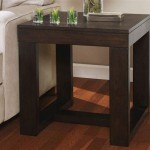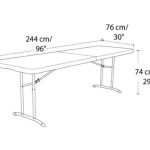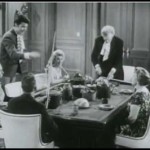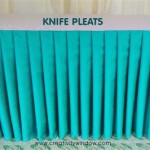The Timeless Elegance of Art Deco Round Dining Tables
The Art Deco movement, flourishing from the 1920s through the 1930s, left an indelible mark on art, architecture, fashion, and design. Characterized by its opulent materials, geometric forms, and streamlined silhouettes, Art Deco represented a modern aesthetic that embraced technological advancement and a sense of sophisticated glamour. Within the realm of furniture, the Art Deco style translated into pieces that were both functional and visually striking. The round dining table, in particular, became a popular choice, embodying the movement's key principles and offering a unique approach to social gatherings and dining experiences.
The appeal of Art Deco round dining tables lies in their inherent ability to foster inclusivity and conversation. Unlike rectangular or square tables that often emphasize hierarchy and distance, a round table promotes equal engagement among diners. This design encourages interaction and a sense of community, making it ideal for both intimate gatherings and larger dinner parties. Beyond its functional advantages, the Art Deco round dining table also serves as a focal point, drawing the eye and contributing to the overall aesthetic of the dining space. Its smooth, continuous surface and often elaborate base create a sense of visual harmony that complements the surrounding decor.
The design of Art Deco furniture, including round dining tables, often reflected the era’s fascination with technological progress. Sleek lines and polished surfaces were common, echoing the streamlined forms of automobiles, airplanes, and skyscrapers. The use of new materials, such as chrome, Bakelite, and exotic woods, further enhanced the modern appeal of these pieces. In contrast to the ornate and heavily ornamented styles of previous eras, Art Deco furniture embraced simplicity and functionality, albeit with a touch of extravagance.
Key Characteristics of Art Deco Round Dining Tables
Several distinguishing features define Art Deco round dining tables and contribute to their enduring appeal. These characteristics reflect the movement's core aesthetic principles and differentiate them from other furniture styles.
Geometric Shapes and Symmetry: Art Deco design is inherently geometric. Round dining tables, while inherently circular in their tabletop form, often incorporate geometric elements in their bases. These can include stepped pedestals, angular supports, or repeating patterns. Symmetry is also a crucial aspect, with balanced and harmonious proportions being a defining feature. The overall design aims for a sense of order and structure, reflecting the machine age ideals of precision and efficiency. This emphasis on geometry can be seen in the use of concentric circles within the table's design, or in the multi-faceted construction of the base.
Luxurious Materials and Finishes: The Art Deco era was synonymous with luxury, and this is reflected in the materials used to create Art Deco furniture. Round dining tables were often crafted from exotic woods such as Macassar ebony, rosewood, and zebrawood, showcasing intricate grain patterns and rich colors. These woods were often highly polished to create a lustrous sheen that accentuated their natural beauty. Chrome accents were also common, providing a striking contrast to the warmth of the wood and adding a touch of modernity. Other materials, such as lacquer, ivory, and shagreen (sharkskin), were sometimes incorporated to further enhance the opulence and visual appeal of the table.
Streamlined Silhouettes and Decorative Details: While Art Deco furniture emphasizes geometric forms, it also embraces streamlined silhouettes. Round dining tables often feature clean lines and smooth curves, contributing to a sense of elegance and sophistication. Decorative details, while present, are typically restrained and integrated seamlessly into the overall design. Examples include inlaid patterns, geometric motifs, and stylized floral elements. The focus is on enhancing the beauty of the piece without overwhelming its inherent simplicity. The combination of streamlined shapes and carefully chosen embellishments creates a harmonious balance between form and function.
Materials Commonly Found in Art Deco Round Dining Tables
The choice of materials played a critical role in defining the Art Deco aesthetic. The selection of materials for round dining tables was carefully considered to reflect the era's emphasis on luxury, modernity, and craftsmanship.
Exotic Woods: As previously mentioned, exotic woods were a hallmark of Art Deco furniture. Macassar ebony, with its striking black and brown stripes, was highly prized for its dramatic appearance. Rosewood, known for its reddish-brown hue and intricate grain patterns, added warmth and elegance to dining tables. Zebrawood, characterized by its bold, contrasting stripes, provided a visually arresting element. These woods were often sourced from distant lands, reflecting the era's increasing globalization and access to international resources. The use of exotic woods elevated the status of Art Deco furniture, transforming it into a symbol of wealth and sophistication.
Chrome and Metals: Chrome, a shiny, durable metal, was a popular choice for Art Deco furniture, representing the era’s embrace of technology and industrial design. Chrome was often used for the bases of round dining tables, providing a sleek and modern contrast to the natural warmth of the wood tabletop. Polished brass and other metals were also used, adding a touch of glamour and sophistication. Metal accents were frequently incorporated into the table's design, such as decorative bands or geometric inlays, further enhancing its visual appeal. The cool, reflective quality of metal contrasted beautifully with the rich tones of the wood, creating a dynamic interplay of textures and colors.
Lacquer and Other Finishes: Lacquer, a glossy and durable finish, was frequently used to enhance the beauty and protect the surfaces of Art Deco furniture. Lacquered finishes created a smooth, reflective surface that accentuated the lines and curves of the table. Other finishes, such as veneers and inlays, were also used to add decorative details and visual interest. Ivory and shagreen, while less common, were sometimes incorporated as luxurious accents, further elevating the status of the piece. The careful selection and application of finishes played a crucial role in achieving the polished and sophisticated look that characterized Art Deco design.
Incorporating Art Deco Round Dining Tables into Modern Interiors
While Art Deco originated nearly a century ago, its timeless elegance continues to resonate with contemporary designers and homeowners. Incorporating an Art Deco round dining table into a modern interior can add a touch of sophistication, glamour, and historical charm to a space.
Balancing Old and New: Successfully integrating an Art Deco piece into a modern setting requires a careful balance between old and new. Avoid creating a space that feels like a museum by mixing the Art Deco table with contemporary chairs, lighting fixtures, and accessories. Consider using a modern chandelier with clean lines and a minimalist design to complement the table's geometric forms. Upholstered chairs in neutral colors can provide a comfortable and stylish contrast to the table's rich wood tones. The goal is to create a cohesive and harmonious space that celebrates both the past and the present.
Creating a Focal Point: An Art Deco round dining table can serve as a stunning focal point in a dining room. Position the table in a central location where it can be easily admired. Surround it with complementary pieces, such as a vintage sideboard or a modern artwork, to create a visually appealing vignette. Consider using a rug with a geometric pattern or a bold color to further define the dining area and draw attention to the table. The key is to create a sense of visual balance and harmony, ensuring that the table remains the star of the show.
Accessorizing with Art Deco Influences: Extend the Art Deco aesthetic throughout the dining room by incorporating accessories that reflect the movement's key principles. Consider using geometric-patterned tableware, such as plates, bowls, and glasses, to complement the table's design. Choose lighting fixtures with streamlined shapes and metallic finishes to enhance the overall sense of glamour. Display artwork that features geometric motifs, stylized figures, or scenes of urban life. By carefully selecting accessories that reflect the Art Deco style, you can create a cohesive and immersive dining experience.
The Art Deco round dining table stands as a testament to the enduring appeal of this influential design movement. Its combination of luxurious materials, geometric forms, and streamlined silhouettes creates a piece that is both functional and visually striking. Whether incorporated into a traditional or modern setting, an Art Deco round dining table can add a touch of timeless elegance and sophisticated charm to any dining space.

Art Deco Inspired Style Round Dining Table Wood

Art Deco Style Round Extending Dining Table 84

Art Deco Style Dining Room Interior Decor

Experience The Best Of 80s With Our Art Deco Round Dining Table Perfect Blend Style And Functionality For Your Work From Home

Art Deco Decoforma Series Round Dining Table From Schuitema For At Pamono

Art Deco Style Round Extending Dining Table Chairish

Art Deco Inspired Round Dining Table

Dining Tables Archives James Salmond Furniture
Julieta High Gloss Round Dining Table Palm Springs Style By Jover Valls Wescover Tables

Premium Photo Luxurious Trendy Dining Room Interior In Art Deco Style Beige With Green Furniture Rectangular Table Six Chairs 3d Rendering








